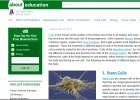Cargando...
Recursos educativos
-
Nivel educativo
-
Competencias
-
Tipología
-
Idioma
-
Tipo de medio
-
Tipo de actividad
-
Destinatarios
-
Tipo de audiencia
-
Creador
Lo más buscado
- Aprender a multiplicar
- Letras T
- Centenas de millar
- Repaso de lengua castellana para primero
- Actividades para primaria para imprimir
- Huesos del cuerpo humano en básica
- Lógica
- Conflictos contemporáneos
- Actividades educativas para niños tercero
- Países de América
- Alimentación saludable en segundo nivel
- Chimpancés
- Contaminación acustica
- Lecturas comprensivas para imprimir
- Reproducción animal
-

Select. Organs of the human body
EduBook Organización
- 2501 visitas
Decide if the items on this list are organs of the human body or not: muscular cell ➝ skin tissue ➝ stomach ➝ digestive system ➝ heart ➝ circulatory system ➝ liver ➝ small intestine ➝…
-

Answer. Amphibians and reptiles
EduBook Organización
- 2432 visitas
Remember what you have studied in this section and answer the questions: Where do amphibians live? Why is the skin of amphibians moist and slimy? How do reptiles move from place to place?
-

-

Describe. The characteristics of vertebrates
EduBook Organización
- 1869 visitas
With a word or short phrase describe the following characteristics in fish, amphibians, birds and mammals: Type of skin. Shape of body. Appendages. Respiratory aparatus. Body temperature regulation.…
-

Match. Amphibians
EduBook Organización
- 1672 visitas
Match each characteristic with the group of animals among which it is most common. They begin life as tadpoles. External fertilisation. Thin, moist, slippery skin. They have a tail.
-

Types of Cells in the Body - About
Cristina Seco Organización
- 1462 visitas
This page discusses a number of different specialist cell types that are found in the human body. These include stem, blood, fat, skin, endothelial, nerve, sex and cancer cells
-

Final self-evaluation 11.08 - The Animal Kingdom (II). Vertebrates
EduBook Organización
- 4679 visitas
Are the following sentences true or false? Reptiles have waterproof skin. Reptiles breathe through gills. A fish's swim bladder gives it information about its surroundings in the water. Birds have…
-

Fungi and lichens
EduBook Organización
- 3309 visitas
6.1. Fungi Fungi are heterotrophic organisms (parasites or saprophytes) that have many different unicellular and multicellular forms: Mushrooms, which grow in forests and fields. Moulds, which grow on…
-

Match. Groups of vertebrates
EduBook Organización
- 2682 visitas
Match each group of vertebrates with its main characteristic: Their body is covered in feathers. ➝ Their body is covered in fur and they give birth to live young. ➝ They spend part of their lives in…
-

The lobes of the cerebral cortex
EduBook Organización
- 2492 visitas
The cerebral cortex is divided into two hemispheres (halves): the right and the left. There are four regions in each half which are called lobes. Each of these regions have different functions. The…
Te estamos redirigiendo a la ficha del libro...













